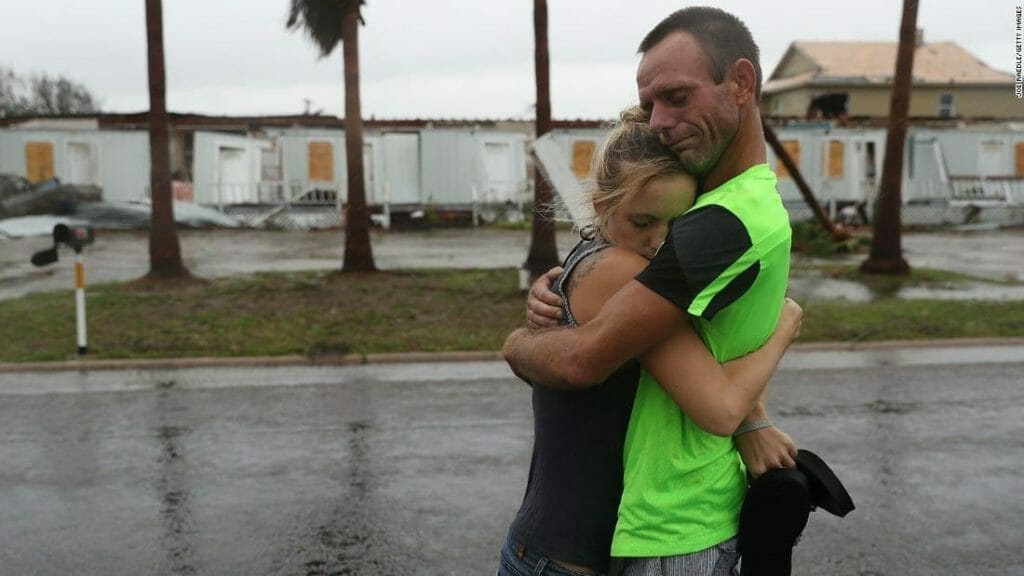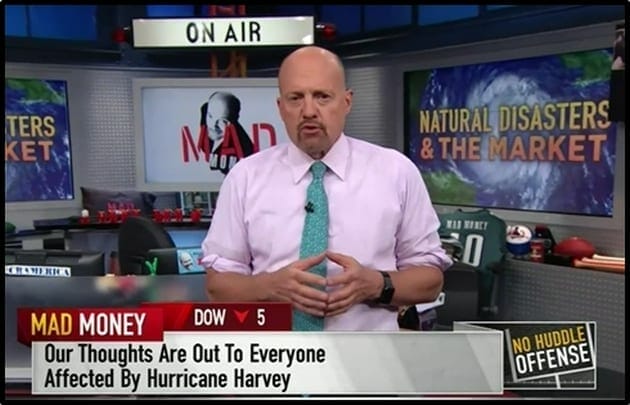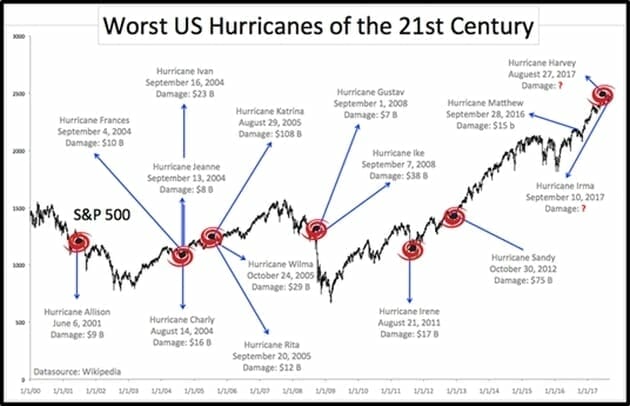Now that the dust has settled on this phase of the hurricane season – let’s take stock.
Hurricane Harvey was a rain event that damaged 300,000 homes and killed 82 people. Hurricane Irma was a wind event that damaged 200,000 homes and killed 69 people.
The lost lives cannot be retrieved or repaired. The homes can be. Moody’s Analytics estimates a $150 billion repair price tag – about the same as Hurricane Katrina.
An excited army of investment pundits spent the week advising their followers how to profit from the two hurricanes.
The go-to play is picking up shares in over-sold insurance companies.
“Buying Allstate after a major hurricane makes landfall is an easy approach to grab profits. If you want a more aggressive approach, you can grab the Allstate January 2018 $85 call option at the market price.
Just wait ‘til after Irma is done making landfall in the U.S. before placing the trade.
Allstate’s share price will rebound, handing you a solid gain.”
Flood damage is not included in standard home-owners insurance policies, but flood damage to businesses is covered by commercial policies.
The second most popular investment idea is buying shares in companies positioned to profit from the massive rebuild.
“In the aftermath of the destruction of Hurricane Harvey, one company stands to profit greatly – Sterling Construction (STRL.NASDAQ). Sterling has the skills, equipment, and experience in the area flooded by Hurricane Harvey to win the reconstruction jobs.”
Other investment pundits got so dizzy pondering the cornucopia of wealth-creation opportunities – that they became incoherent.
“Roofing and building material stocks can be traded from the long side if a short squeeze is developing. Ultimately big money is made by short selling the overshoot at the end of the short squeeze.”
Say what?
We’d probably have more luck trading Hong Kong platinum derivatives than trying to overshoot the end of a short squeeze.
Finally, Jim Cramer – the former ice-cream salesman and current pitch man for CNBC’s The Street – weighed in.
“Look, I feel miserable telling you how to profit from this very sad event,” said Cramer making a poopy-face, “But I think these insurers are all buys after another day or two of selling, as I expect the federal flood program will bear the brunt of the losses.”
Cramer’s last point is correct: the U.S. government is going to write the big cheques.
FEMA has already received 800,000 applications for assistance related to Harvey – distributing $380 million. The agency has received 160,000 Irma applications and released $21 million.
Congress tossed in $15 billion in hurricane aid just to keep everything lubricated. Naturally, a lot of that money will flow into the coffers of publicly traded companies.
So who can blame the pundits for scrambling to identify post-disaster stock market trends?
In 2005 Hurricane Katrina and killed more than 1,300 people. Estimated cost to the US economy was $42 billion, with 380,000 jobs lost. But Katrina had a negligible effect on New York Stock Exchange in the following 90 days.
Following Harvey and Irma – the U.S. stock indexes burped impolitely and then continued their uphill climb, undeterred by the fallout from the deadly strong winds.
A U.S statistical think tank published a massive report, packed with formulas like this Rit = αi + βiRmt + εit (where Rit is the return of the stock i on Day, βi is a measure of the sensitivity between Rit with respect to…etc).
The think-tank’s conclusion?
“Using parametric and non-parametric statistical tests, our hurricane investment findings indicated that the short-term economic impact was small and the market’s resilience in the days following storms indicates that investors do not panic.”
So here’s the reality: when a natural disaster happens, the big opportunity is for skilled day-traders – like the dudes who bought put-options on orange juice futures as Hurricane Irma rolled into Florida.
But there aren’t many successful day-traders. In any fiscal year, 96% of them lose money. Within three years of starting a day-trading career, only 13% continue. After five years, only 7% persevere.
That’s why it’s stupid to try to profit from misery.
Full Disclosure: we find Jim Cramer annoying.




